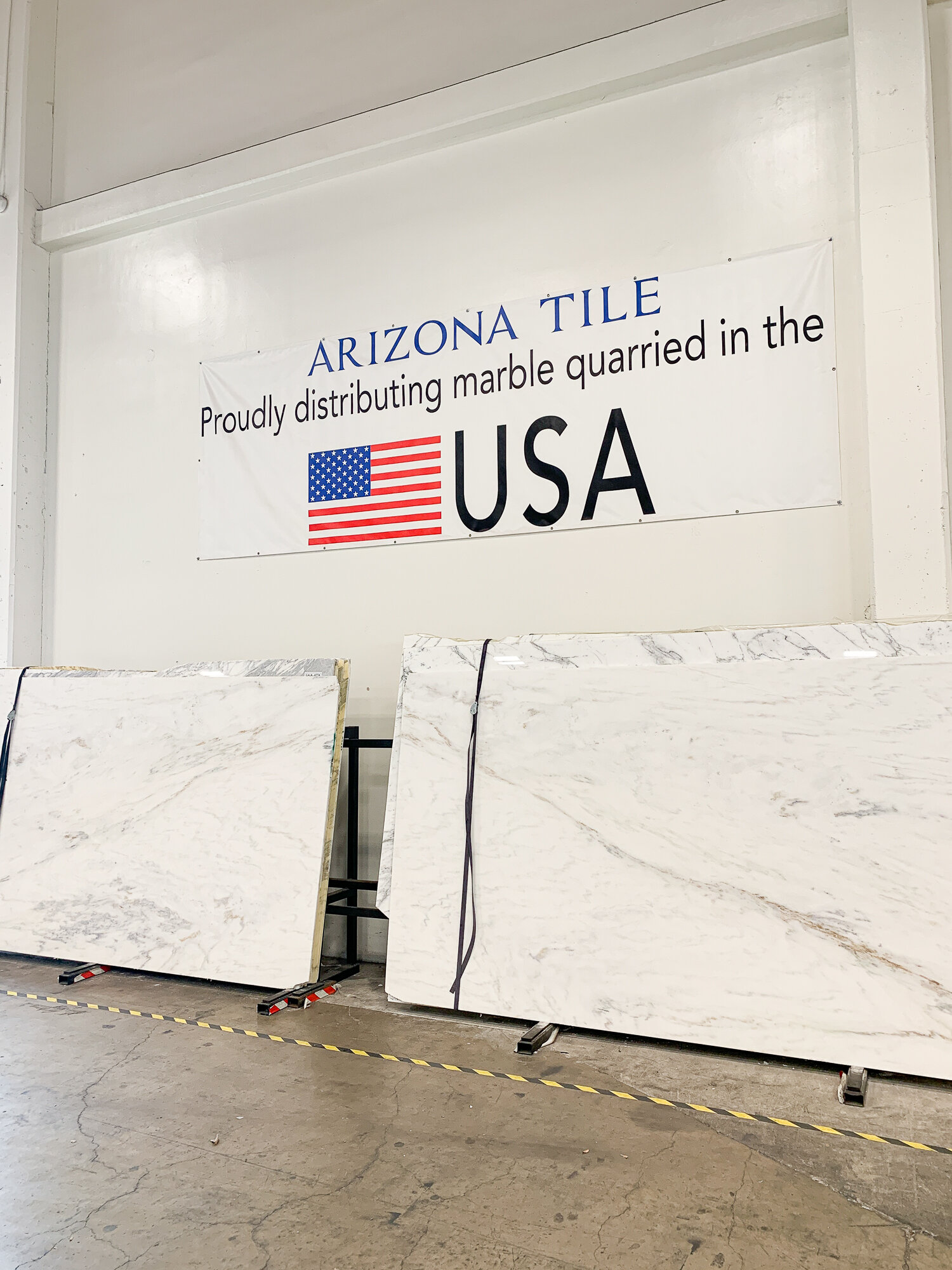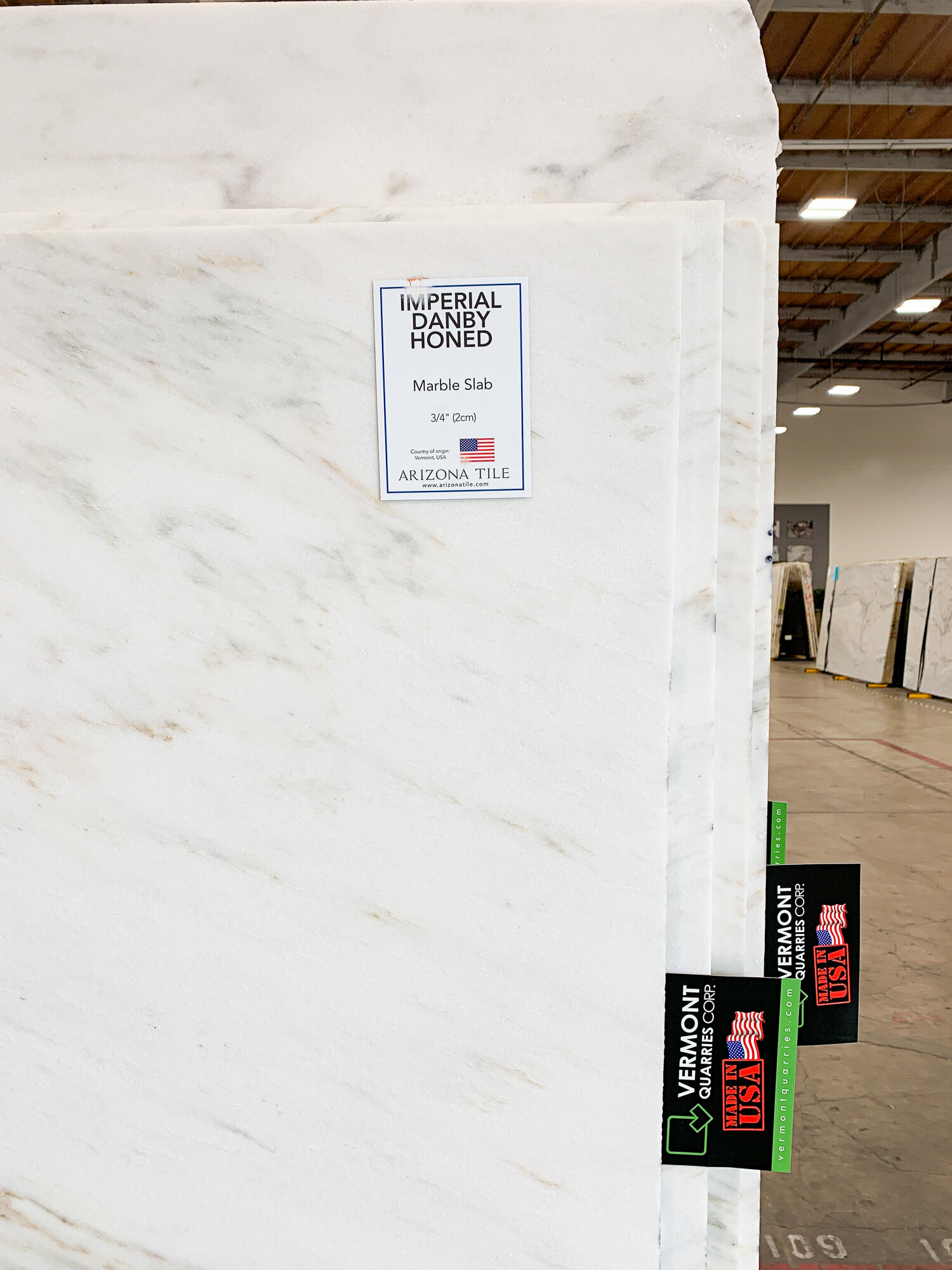Researching a Sustainable Kitchen Countertop and Why I Chose Marble
/Countertops are major workhorses and one of the biggest design elements in a kitchen. So, there’s a lot of thought that goes into the material, style, and design of them. But you know me, I have to research even further. In addition to picking a pretty countertop, I factored in the environmental footprint, worker health, land reclamation of the quarry, and the way it fits into a historic home. Ready to get into it? Let’s!
This blog post is sponsored by Natural Stone Institute and in partnership with Arizona Tile. As always, all opinions are my own. In fact, I did all of this research and decision-making before reaching out to these companies. Thanks for supporting the brands that help me keep the blogging lights on!
Video of hunting for the perfect countertop:
I’m going to give you the nitty-gritty of shopping for countertops below, but take a look at the video below to see us strolling through the slab selection at Arizona Tile. I feature the difference between polished and honed, I color match to my cabinetry paint, and show off the different types of stone.
Spoiler! I chose Imperial Danby Marble from a quarry in Vermont, USA. I’ll explain why I picked this exact material down to the specific quarry it’s sourced from.
Old Material For An old House
I’m not a total purist that everything in my home needs to be old. But it sure is a goal to use materials that are in keeping with my 106-year-old home. The countertop materials that would have been used in homes of this age are marble, soapstone, hardwood, ceramic, or any local materials specific to a home’s region. Remember what Georgie said about an efficient kitchen in 1915? While engineered stones are popular today, my goal was to use a countertop material that would fit my historic craftsman home. This rules out composite and engineered surfaces in favor of natural stones.
Design, Look, and Feel
We all know marble is gorgeous on the eyes - no question. But there’s so much more than just the look of something, especially when it’s a workhorse - there’s touch. Marble has an unmistakable feel to it that man-made products simply don’t have. If you ever wonder if something that looks like marble is actually marble, just touch it. If it’s cold, it’s marble! Delicious delicious marble. As a fan of baking, I like the way marble becomes a tool when I make pie crusts with its naturally cold surface. (Psst: the secret to good pie crust is to keep everything cold cold cold!) Speaking of stones with a great feel, note that soapstone also has a magical texture that I’d encourage you to rub up against. We drifted away from the idea of soapstone because it’s limited to black hues and I wanted a white countertop.
Sustainability & Ethics
Worker Safety
When shopping for any product, I consider the ethics of sourcing the materials and how it impacts workers and their communities - not just the safety in my own home. I was saddened to hear reporting of workers in the countertop fabrication industry who were inhaling silica dust which is tragically killing them at a young age from silicosis, a lung disease. This news steered me to select a material that has little to no silica - marble. But since other natural stones and engineered stones do contain silica, it’s important to push for change industry-wide by supporting the fabricators doing right by the safety of their workers. To ensure worker safety, make sure you’re working with a fabricator that is following established industry standards and maintaining OSHA compliance. Companies that have certified to the Natural Stone Sustainability Standard or are Accredited by Natural Stone Institute have already verified compliance. I turned to Arizona Tile for their commitment to safety.
Land Reclamation
Before beginning my research, I was worried about the sustainability of harvesting big heavy things from the earth. I thought it was like strip mining which destroys landscapes and wildlife habitats, then leads to soil erosion and sediment pollution in waterways. But silly me, that isn’t how stone is quarried! Click here to learn more about the quarry process which involves small footprints, precise low-waste harvesting, and reclamation options. After the quarry is retired, it can be turned into natural habitat sanctuaries like Quarry Gardens at Schuyler which is made up of public gardens, native plantings, and conservation efforts. I almost cried when I saw how beautiful the retired quarry is! The quarry I ordered my marble from is free of landscape destruction, uses all-electric cutting machines, has daily air sampling for worker safety, and it’s simply gorgeous. Take a look at this cool video tour of the quarry. I encourage you to look for certified quarries to ensure they’re meeting safety and environmental standards.
Transportation
Once those big pieces of stone are pulled from the earth, they have to travel to distribution sites, then to fabricators, then to our homes. Most marble is shipped in from Italy where it’s quarried. Some comes from Brazil, India, or other faraway lands from my home in California. I decided that one way I could make my countertop environmental footprint smaller is to look only at North American quarries so the stone didn’t have to travel as far. There are quarries throughout the United States but based on availability at my local Arizona Tile slab yard and types of stone in production, I went with Vermont Danby Marble which is based in Mendon, VT.
Durability and Timelessness
One of my home improvement philosophies is that investing in timeless elements is a sustainable choice. Opting for a classic marble rather than a trendy or stylized material will ensure the material stays in the home, even after I move out. Preventing something from getting demolished and taken to the dump down the road is always an environmental choice. While I hope that nobody demolishes my new kitchen anytime soon, I’m very confident that whenever the kitchen is eventually remodeled, it isn’t because the marble looks dated.
Natural stones get a bad reputation for being fragile - a concept promoted by the engineered stone community. But I must say that the 500-year-old marble in Italy looks pretty good for its age! So I think a countertop in my home will do just fine, and it will even outlive me. And if it doesn’t last half a century, the good news is marble is recyclable without causing silicosis for the workers that will reshape it into other items. Here’s more on the lifecycle of natural stone. And for maintenance and cleaning of natural stones, click here.
Overall Sustainability
I could go on and on, but for the sake of brevity, I’ll keep this post only to the essentials. Here are articles that go more in-depth about natural stone’s impact on the environment and people:
Debunking Myths
“Marble is pricey”
There are a bunch of different price points for natural stone. Yes, you can buy a $120/sq ft slab, but comparing that to an engineered stone would be like comparing an apple to something more special like a dragon fruit. I called up my local Arizona Tile Slab Yard and Jeff said that marble ranges from $15-$120/sq ft (the Imperial Danby marble I got is $65/sq ft) with the mid-range being more in the $30-$50/sq ft. Engineered quartz is more like $14-$40/sq ft. So if your budget is in the $15-$40 range, you can definitely get marble for the same price as engineered quartz!
“Marble will etch and stain”
First, yes, natural materials do wear over time. Wood scratches, leather scuffs, glass breaks, and stone etches. And that is the beauty of a living material not filled with a synthetic plastic. I chose to embrace the patina of natural surfaces. But, if you want stone in tip top shape, there are ways to keep it that way! Marble sealers today are incredibly successful in avoiding stains! Spoiler, I sealed my marble myself and haven’t had a single stain in months of wear - more on that here. But if marble does stain, it can be so easily removed, too. Etches are more common in marble, and my stone has etched already. Some of it is character, and some of it I remove with an etch remover.
I also opted for honed marble as opposed to polished marble. Honed is a softer finish that hides etches whereas polished stone is less forgiving.
“Marble is too soft or porous for countertops”
It’s true that not all marbles are great for countertops, just like not all woods are good for furniture. When hunting for a marble optimal for a countertop, you’ll look at the hardness and absorption rates. One of the reasons I picked Imperial Danby marble is it has an absorption rate of 0.6% which is extremely low - lower than the popular granites used today. If you want a scientific guide to shopping for stone, click here to learn about hardness, durability, acid resistance and porosity. And if you really want to nerd out, here’s a technical bulletin for you.
Martha Stewart-Approved
Uhm, excuse me, but Martha Stewart and I have the exact same marble in our kitchens! Here she is casually leaning against her Vermont-quarried Imperial Danby honed marble. The original influencer, the queen, THE Martha Stewart used this stone in her kitchen (actually, she’s used it in three of her homes). And if it’s good enough for her, it’s good enough for me.
In conclusion, marble was the right choice for us and I’m so so happy we went with it. In fact, it’s been installed in my kitchen for months now and it’s absolutely beautiful. The stone I chose has gorgeous pale grey and tan veining that works perfectly with the warm tones I’m using in my kitchen. I can’t wait to show more of it off to you soon. UPDATE: learn all about the installation and design process here then read up on the sealing process here.
If you’re interested in learning more about natural stone, check out the resources at Use Natural Stone or Natural Stone Institute. And if you want to check out your local Arizona Tile slab yard, click here for locations. Psst! Be sure to check out the Imperial Danby, it’s Martha Stewart and Ashley approved.
































